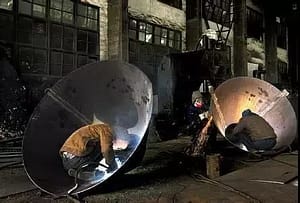Causes of Lamellar Tearing and How to Prevent?
Causes of Lamellar Tearing and How to Prevent?
Three general categories:
The first one is lamellar tearing induced by cold crack at weld toe or root in haz.
The second is the heat-affected zone along the inclusion cracks, is the most common engineering layered tearing.
The third type of matrix crack far away from the heat-affected zone (haz) usually occurs in the thick plate structure with more MNS.

There are many factors that affect lamellar tear, including:
1. The type, amount and distribution of non-metallic inclusions are the essential reasons of lamellar tearing, which is the root of anisotropy and mechanical properties difference of steel.
2. In the course of welding, the thick-wall welded structures with Z-constraint stress bear different Z-constraint stress, post-welding residual stress and load, which are the mechanical conditions that cause lamellar tearing.
3. It is generally believed that hydrogen is an important factor in the formation of lamellar tears induced by cold cracking near the heat-affected zone.
Because of the great influence of lamellar tearing and its serious harm, it is necessary to judge the sensitivity of steel lamellar tearing before construction.
The common evaluation methods are the shrinkage of Z-direction tensile section and the z-direction critical stress method. To prevent lamellar tearing, the section shrinkage should not be less than 15% , the general hope is 15 ~ 20% , when 25% , considered excellent resistance to lamellar tearing.
Measures to prevent lamellar tearing should be taken mainly in the following areas:
Firstly, the ultra-low sulfur steel containing only 0.003-0.005% S can be obtained by adopting the method of hot metal desulphurization in advance and degassing in vacuum, and its section shrinkage (z direction) can reach 23-25%.
Secondly, the shape of sulfide inclusions is controlled by changing MNS into sulfide of other elements, which makes it difficult to elongate during hot rolling, thus reducing anisotropy. Calcium and rare earth elements are widely used as additives. The steel treated by the above mentioned method can produce the lamellar tear-resistant steel plate with Z-direction section shrinkage rate of 50 ~ 70%.
Thirdly, from the point of view of preventing lamellar tearing, the design and construction techniques are mainly to avoid z-direction stress and stress concentration:
1) One side weld should be avoided as far as possible, and the use of double side weld can ease the stress state of root zone of weld to prevent stress concentration.
2) The symmetrical fillet weld with less welding quantity is used to replace the full penetration weld with large welding quantity to avoid excessive stress.
3) The groove should be opened on the side bearing z-direction stress.
4) For t-joint, a layer of low strength welding material can be surfacing on the transverse plate in advance to prevent root cracking and to ease welding strain.
5) Some measures should be taken to prevent cold cracking, such as reducing hydrogen content, properly increasing preheating, controlling interlaminar temperature, etc..
Learn more our project quality managemet, QAQC and third party inspection (TPI), NDT practices thru below link.-
https://www.jsc-safe.com/mechanical-inspection-installation-commissioning/
